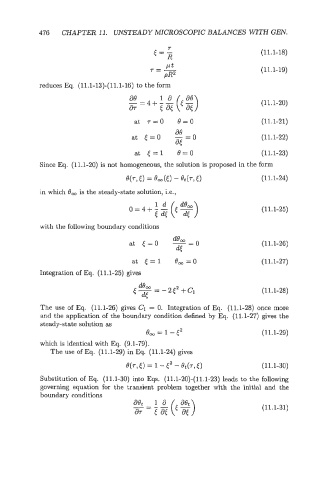Page 496 - Modelling in Transport Phenomena A Conceptual Approach
P. 496
476 CHAPTER 11. UNSTEADY MICROSCOPIC BALANCES WITH GEN.
r
I=- (1 1.1-18)
R
(1 1.1-19)
reduces Eq. (11.1-13)-(11.1-16) to the form
(11.1-20)
at T=O 8=0 (11.1-21)
ae
at E=O -=0 (1 1.1-22)
%
at t=l e=O (1 1.1-23)
Since Eq. (11.1-20) is not homogeneous, the solution is proposed in the form
@(T, E) = eOo(0 - et(T, 0 (I 1.1-24)
in which Boo is the steady-state solution, i.e.,
(11.1-25)
with the following boundary conditions
at <=O de, (11.1-26)
-- -0
dE
at t=1 e,=O (1 1.1-27)
Integration of Eq. (11.1-25) gives
(11.1-28)
The use of Q. (11.1-26) gives CI = 0. Integration of Eq. (11.1-28) once more
and the application of the boundary condition defined by Eq. (11.1-27) gives the
steady-state solution as
e,=i-t2 (1 1.1-29)
which is identical with Eq. (9.1-79).
The use of Eq. (11.1-29) in Eq. (11.1-24) gives
e(T, t) = 1 - t2 - Ot(T, t) (11.1-30)
Substitution of Eq. (11.1-30) into Eqs. (11.1-20)-(11.1-23) leads to the following
governing equation for the transient problem together with the initial and the
boundarv conditions
(11.1-31)

